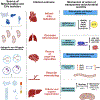Therapeutic transplantation of mitochondria and Extracellular Vesicles: Mechanistic insights into mitochondria bioenergetics, redox signaling, and organelle dynamics in preclinical models
- PMID: 40570985
- PMCID: PMC12382009
- DOI: 10.1016/j.freeradbiomed.2025.06.040
Therapeutic transplantation of mitochondria and Extracellular Vesicles: Mechanistic insights into mitochondria bioenergetics, redox signaling, and organelle dynamics in preclinical models
Abstract
Mitochondrial and extracellular vesicles (EV) transplantation have emerged as promising therapeutic strategies targeting mitochondrial dysfunction, a central feature of numerous pathologies. This review synthesizes preclinical data on artificial mitochondrial and EV transfer, emphasizing their therapeutic potential and underlying mechanisms. A systematic analysis of 123 animal studies revealed consistent benefits across diverse models, including ischemia-reperfusion injury (IRI), neurological disorders, drug-induced toxicities, and sepsis. Mitochondrial transfer improved organ function, reduced inflammation and apoptosis, and enhanced survival. Mechanistic insights revealed restored bioenergetics, increased oxidative phosphorylation, redox balance through activation of specific pathways, and modulation of mitochondrial dynamics via fusion/fission proteins. Mitochondrial homeostasis was supported through elevated mitophagy and biogenesis, alongside the preservation of mitochondrial-associated membranes. EV demonstrated similar effects, offering a potentially more targeted therapeutic alternative. Although pre-clinical studies have demonstrated safety and feasibility, broader application is limited by variability in isolation methods, lack of mechanistic clarity, and minimal human data. Standardization and mechanistic validation are critical to advance clinical translation. This review underscores the therapeutic promise of mitochondrial and EV transfer while highlighting the need for continued research to refine these interventions and unlock their full potential in regenerative medicine.
Keywords: Artificial mitochondrial transfer; Extracellular vesicles; Microvesicles; Mitochondrial transplantation; Pre-clinical data; Therapeutic; Treatment.
Copyright © 2025 The Authors. Published by Elsevier Inc. All rights reserved.
Conflict of interest statement
Declaration of competing interest The authors declare that they have no known competing financial interests or personal relationships that could have appeared to influence the work reported in this paper.
Figures



References
Publication types
MeSH terms
Grants and funding
LinkOut - more resources
Full Text Sources

